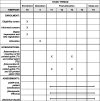3D printed versus milled stabilization splints for the management of bruxism and temporomandibular disorders: study protocol for a randomized prospective single-blinded crossover trial
- PMID: 39238023
- PMCID: PMC11376033
- DOI: 10.1186/s13063-024-08437-7
3D printed versus milled stabilization splints for the management of bruxism and temporomandibular disorders: study protocol for a randomized prospective single-blinded crossover trial
Abstract
Background: Nowadays, stabilization splints for the management of bruxism and temporomandibular disorders (TMD) can be produced utilizing a digital workflow comprising a digital impression of the teeth, digital splint design, and computer-aided manufacturing of the splints. The latter is usually a milling process, however, more recently 3D printing gained popularity due to its better cost and time efficiency. It remains unknown whether 3D printed stabilization splints are inferior to milled splints regarding clinical outcomes.
Methods: This clinical trial assesses the non-inferiority of 3D printed occlusal splints compared to milled occlusal splints in a monocentric prospective randomized single-blinded crossover trial with two cohorts. One cohort includes 20 participants with bruxism, the other 20 participants with pain-related TMD, i.e., myalgia, myofascial pain, or arthralgia of the jaw muscles/the temporomandibular joint(s) diagnosed according to the Diagnostic Criteria for Temporomandibular Disorders (DC/TMD). Michigan-type stabilization splints are fabricated in a digital workflow by milling or 3D printing using CE-marked materials within their intended purpose. The participants wear a milled and a 3D printed splint in a randomized order for 3 months each, with follow-up visits after 2 weeks and 3 months. Investigated outcome parameters are oral health-related quality of life (OHRQoL) evaluated by the Oral Health Impact Profile (OHIP-G14), participant satisfaction as rated on a visual analog scale, therapeutic efficacy, and technical result of the splints. In this context, therapeutic efficacy means antagonist wear and-in the TMD group-reduction of pain/disability assessed by the Graded Chronic Pain Scale (GCPS v2.0) and clinical assessment following the DC/TMD standard, while technical outcome measures splint fit, wear and fracture rate.
Discussion: The trial will provide important information on the clinical outcome of 3D printed stabilization splints in comparison to milled splints and will, therefore, enable an evidence-based decision in favor of or against a manufacturing process. This, in turn, will guarantee for a maximum of the patient's OHRQoL during splint therapy, therapeutic efficacy, and longevity of the splints.
Trial registration: German Clinical Trials Register (DRKS) DRKS00033904. Registered on March 15, 2024.
Keywords: 3D printing; Additive manufacturing; Bruxism; CAD/CAM; Digital dentistry; Milling; Oral health-related quality of life; Stabilization splint; Temporomandibular disorder.
© 2024. The Author(s).
Conflict of interest statement
The authors declare that they have no competing interests.
Figures
References
-
- Yost O, Liverman CT, English R, Mackey S, Bond EC, National Academies of Sciences, Engineering, and Medicine. Prevalence, impact, and costs of treatment for temporomandibular disorders. In: Temporomandibular disorders: priorities for research and care. US: National Academies Press; 2020. - PubMed
Publication types
MeSH terms
LinkOut - more resources
Full Text Sources
Medical
Miscellaneous



